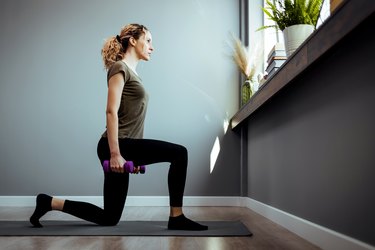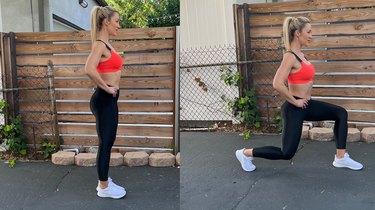
Want to strengthen your lower body without harming your knees? Reverse lunges can help with that no matter your fitness level.
Reverse lunges are a safe exercise that can challenge your lower-body strength and improve your overall stability. Learn how to do this move with good form and discover all the benefits this exercise offers.
Video of the Day
- What is a reverse lunge? It's a single-leg exercise where you step backward and bend your knees until your front knee forms a 90-degree angle. Then, you put most of your weight in your front leg to return to standing.
- What does the reverse lunge work? Reverse lunges primarily target your quads and glutes, and also work your hamstrings and calves. Since you work one leg at a time, they also challenge your balance and stability, according to Caroline Pearce, CPT, exercise physiologist and lead trainer for FitOn App.
- What is the difference between a lunge and a reverse lunge? Forward lunges involve forward movement and put more force on the front of your knee. Reverse lunges are gentler on your knee joint. Also, reverse lunges work your glutes a little more, and front lunges focus on your quads, Pearce says.
How to Do a Reverse Lunge With Perfect Form
Reverse Lunge

- Stand straight with your feet shoulder-width apart and your toes pointed forward.
- Move your right leg back behind your body while simultaneously bending your left knee and lowering your hips. Keep your torso straight.
- Stop when your left knee is at a 90-degree angle and your left thigh is parallel to the floor.
- Pause slightly and press into your left heel, squeezing your glutes to stand up, while bringing your right leg back to the starting position. This is 1 rep.
- Continue doing all your reps on the same leg and then switch sides, or alternate legs, bringing the left leg back next.
Tip
As you lunge, you can lean your chest forward slightly to target your front glute and quad, Pearce says. Or, keep your upper body straight to feel a deeper stretch along the back quad. No matter how you tweak the move, maintain a flat spine (no rounding) throughout.
Watch the Full Tutorial
5 Reverse Lunge Benefits
1. It Works Your Entire Lower Body
Reverse lunges target all the main muscles in your lower body, including your glutes, quads and hamstrings, according to Pearce. And because there's a balancing component involved, they also target the small stabilizing muscles in your hips and thighs.
A stronger lower body helps you do pretty much all of your other activities, like running, lifting and cycling. You use your glutes, hamstrings and quads in and out of the gym, so the more strength you have, the less likely you are to get injured.
2. It's Gentle on Your Knees
As mentioned above, when it comes to reverse lunges versus forward lunges, forward lunges place more force on your knees, according to Pearce. When you reverse lunge, your working leg stays stationary and that's where all the power comes from. This is gentler on your joints than a front lunge where your working knee moves at the same time.
The reverse lunge's knee-friendly nature also makes it an ideal exercise for beginners. The movement is more controlled because your working leg is stable, making it a little safer for lunging newbies.
3. It's Time-Effective
The reverse lunge is a compound exercise, which means it works multiple muscle groups at once. This not only saves you time but also ups the cardiovascular challenge and increases your total calorie burn, according to the American Council on Exercise (ACE). So, if you're short on time but want an effective exercise, this is one to keep in mind.
4. It Helps Even Muscle Imbalances
Reverse lunges are also a unilateral exercise, which means they move one side of your body at a time. Unilateral movements are both challenging for your muscles and help develop even strength across your body.
"As you're moving one leg at a time, you'll develop balanced strength in both legs rather than one leg compensating for the other, which is common in double-leg exercises such as a squat," Pearce says.
Developing balanced strength on both sides of your body is more important than you may think. Muscle imbalances can put you at a higher risk of injury during other exercises or day-to-day activities.
5. It's Easy to Regress and Progress
The reverse lunge variation options (more on that below) are pretty much endless. If you need a little extra assistance, you can do a supported reverse lunge by holding onto the back of a stable chair, countertop or railing.
To make the move harder, add resistance with a pair of dumbbells or kettlebells in each hand or a barbell across your back. You can even turn this move into a true total-body exercise by adding a bicep curl or shoulder press at the top of the movement.
Related Reading
5 Reverse Lunge Form Tips
1. Keep Your Knee Above Your Toes
To avoid injury and unwanted pressure on your knee joints, keep your front knee directly over your front toes, Pearce says. Both your front knee and toes should point forward, too.
As you lunge, glance down at the floor to make sure you can see the very tip of your toes peeking underneath your knee. Or, do your lunges in front of a mirror to ensure your knee and toes stay in line.
Pro tip: You can film yourself doing lunges to make sure your knees stay in the right place.
2. Widen Your Base
Keeping your feet too close together when you step back can make balancing really difficult and add extra joint stress, Pearce says. You want a wider base to help you stay stable and perform the movement as safely as possible.
"Start with your feet shoulder-width apart and make sure as you step back, you keep that same width between your front and back foot," Pearce recommends. "Perform your reverse lunge alongside a line or mat placed on the ground and make sure each foot is on either side of the line or mat edge."
3. Don't Step Too Far Back
"Stepping too far backwards places extra pressure on your hip flexor and creates an unstable (wobbly) base from which to push back to standing," Pearce says. As you lunge, your back knee should be directly in line with your hips.
When you're just getting used to the movement, Pearce recommends using a mirror to get familiar with how the right position looks and feels. Typically your back knee should be hovering just above the ground with your front quad parallel to the ground.
4. Lunge as Deep as Is Comfortable
Not everyone has enough mobility to get their front knee to form a 90-degree angle and back knee just above the ground — and that's totally normal.
"If you're a beginner, be careful not to lunge back farther than your strength and stability will allow," Pearce says. "More advanced exercisers can drop the hips and knees lower towards the ground and try more variations, such as adding weight."
Focus on nailing your form first. Then, deepen your lunge as you become comfortable with the exercise.
5. Don't Use Your Hands
Many people place their hands on their front thigh to help push back into the starting position.
"This is essentially 'cheating' the movement," Pearce says. "It not only places undue stress on the quad and knee, but prevents the quad muscles from activating effectively."
To resist the urge to use your hands, lean your torso forward slightly, so your front leg can more easily push up off the ground. And if you need a little extra assistance, hold the back of a chair or couch for extra stability.
5 Reverse Lunge Variations
Ready for an extra challenge? Try these reverse lunge variations that add resistance or elevation to the basic move.
1. Dumbbell Reverse Lunge
- Stand straight with your feet shoulder-width apart and your toes pointed forward. Hold a dumbbell in each hand.
- Move your right leg back behind your body while simultaneously bending your left knee and lowering your hips. Keep your torso straight.
- Stop when your left knee is at a 90-degree angle and your left thigh is parallel to the floor.
- Pause briefly and press into your left heel, squeezing your glutes to stand up, while bringing your right leg back to the starting position. This is 1 repetition.
- Continue doing all your reps on the same leg and then switch sides, or alternate legs, bringing the left leg back next.
2. Elevated Reverse Lunge
- Stand on an elevated surface (like a box or step) with your feet shoulder-width apart and your toes pointed forward.
- Move your right leg back and down behind your body while simultaneously bending your left knee and lowering your hips. Keep your torso straight.
- Stop when your left knee is at a 90-degree angle and your left thigh is parallel to the floor.
- Pause briefly and press into your left heel, squeezing your glutes to stand back up to the box, bringing your right leg back to the starting position. This is 1 repetition.
- Continue doing all your reps on the same leg and then switch sides, or alternate legs, bringing the left leg back next.
3. Reverse Lunge to Step Up
- Stand in front of an elevated surface (like a box or step) with your feet shoulder-width apart and your toes pointed forward.
- Step your right leg back while simultaneously bending your left knee and lowering your hips. Keep your torso straight.
- Stop when your left knee is at a 90-degree angle and your left thigh is parallel to the floor.
- Pause briefly and press into your left heel, squeezing your glutes to stand back up.
- Place your right foot on the elevated surface.
- Root your right foot onto the box and drive your left knee up toward your chest.
- Step your left knee back down to the floor, and then immediately step your right leg back into another reverse lunge.
- Continue doing all your reps on the same leg. Switch and repeat on the other leg.
4. Barbell Reverse Lunge
- Stand straight with your feet shoulder-width apart and your toes pointed forward. Rest a barbell across the back of your shoulders, and use an overhand grip to hold onto it on either side of your head.
- Move your right leg back behind your body while simultaneously bending your left knee and lowering your hips. Keep your torso straight. Stop when your left knee is at a 90-degree angle and your left thigh is parallel to the floor.
- Pause briefly and push with your left leg, squeezing your glutes to stand up while simultaneously returning your right leg to its starting position. This is 1 repetition.
- Continue doing all your reps on the same leg and then switch sides, or alternate legs, bringing the left leg back next.
5. Glider Reverse Lunge
- Stand straight with your feet shoulder-width apart and your toes pointed forward. Place your right foot on a glider. You can also use a paper plate.
- Press into the glider and slide your right leg back behind your body, simultaneously bending your left knee and lowering your hips. Keep your torso straight.
- Stop when your left knee is at a 90-degree angle and your left thigh is parallel to the floor.
- Pause briefly and push with your left leg, squeezing your glutes to stand up, while pressing into the glider with your right leg and returning to the starting position. This is 1 repetition.
- Continue doing all your reps on the same leg. Switch and repeat on the other leg.
Related Reading